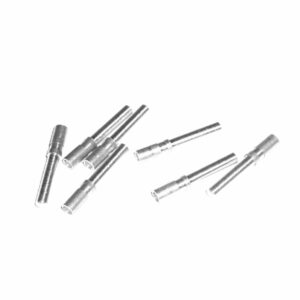H61 Brass pins
HPb61-1 lead brass standard: (GB/T 5231-2001)
Characteristics and scope of application: It is a widely used lead brass, good machinability, good mechanical properties, can withstand cold and hot pressure processing, easy fiber welding and welding, and has good stability to general corrosion.
Brass is an alloy composed of copper and zinc, brass composed of copper and zinc is called ordinary brass, if it is composed of more than two kinds of alloy is called special brass.
Chemical Domposition
| Mark | Cu | Zn | Pb | P | Al | Fe | Si | Sb | Bi | Other |
| H61 | 57-60 | balance | 0.8~1.9 | ≤0.02 | ≤0.2 | ≤0.5 | – | ≤0.01 | ≤0.003 | ≤1.0 |
common brass
It is an alloy of copper and zinc.
When the zinc content is less than 35%, zinc can dissolve in copper to form a single-phase α, called single-phase brass, good plasticity, suitable for hot and cold pressure processing.
When the zinc content is 36% to 46%, there are α single phase and β solid solution based on copper and zinc, called biphase brass, β phase makes the brass plastic reduction and tensile strength increase, only suitable for hot pressure processing.
If the mass fraction of zinc continues to increase, the tensile strength decreases and has no use value.
The code is denoted by “H + number”, where H stands for brass and the number represents the mass fraction of copper.
For example, H68 indicates brass with a copper content of 68% and zinc content of 32%, and casting brass is preceded by a “Z”, such as ZH62.
For example, ZCuZnzn38 indicates cast brass with a zinc content of 38% and a margin of copper.
H90 and H80 are single-phase brass, golden yellow.
H59 is biphase brass, widely used in electrical structures such as bolts, nuts, washers, springs, etc.
Under normal circumstances, single-phase brass is used for cold deformation processing, and biphase brass is used for hot deformation processing.
special brass
A multicomponent alloy composed of other alloying elements added to ordinary brass is called special brass. Often added elements are lead, tin, aluminum, etc., which can be called lead brass, tin brass, aluminum brass. The purpose of adding alloying elements. It is mainly to improve the tensile strength to improve the processability.
Code: for “H + main plus element symbol (except zinc) + copper mass fraction + main plus element mass fraction + other element mass fraction”.
For example, HPb59-1 means that the mass fraction of copper is 59%, the mass fraction of lead containing the main additive element is 1%, and the margin is zinc lead brass.
mechanical property
Tensile strength σb (MPa) : ≥390
elongation δ10 (%) : ≥12
Elongation δ5 (%) : ≥14
Due to the different zinc content in brass, the mechanical properties are not the same, and the mechanical properties of brass change with the different zinc content. For alpha brass, both σb and δ increase with the increase of zinc content. For (α+β) brass, the room temperature strength continues to increase until the zinc content is increased to about 45%. If the zinc content is further increased, the strength decreases sharply due to the appearance of a more brittle r phase (a solid solution based on Cu5Zn8 compound) in the alloy structure. The room temperature ductility of (α+β) brass always decreases with the increase of zinc content. Therefore, the copper zinc alloy with zinc content of more than 45% has no practical value.





Reviews
There are no reviews yet.